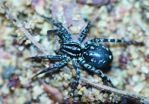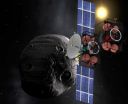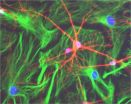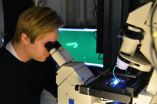(Press-News.org) The species from the genus Copa are very common spiders found in the leaf litter of various habitats. Being predominantly ground-living, they occur widely in savanna woodlands but also occasionally in forests, where they are well camouflaged. They usually share the litter microhabitats with several other species of the family Corinnidae. The spiders from this cryptic, ground-dwelling genus in the continental Afrotropical Region are revised in a study published in the open access journal Zookeys.
The number of continental species in the Afrotropical Region has been reduced from four to two, one of which is newly described. While C. flavoplumosa is widespread throughout the region (from Guineé in the west to Tanzania in the east, and from Nigeria in the north to South Africa in the south), the new species, C. kei, is endemic to southeastern South Africa.
The two species represent extremes regarding both vagility and ecological flexibility. C. flavoplumosa provides a useful example of extreme habitat flexibility, occupying habitats from forests to semi-deserts. It is particularly prevalent in savanna habitats on the continent, but also occurs in various forest types and grasslands. They have been occasionally collected in agroecosystems, specifically from the canopies of orchard crops in South Africa (avocadoes, macadamias and pistachios), which is in stark contrast to their almost exclusive ground-dwelling habits in natural habitats. The reasons for this ecological divergence, however, are unknown.
The newly described species, C. kei, is very closely associated and believed to be endemic to the Afromontane and coastal forests in South Africa. The species has a distribution falling entirely within the Maputaland-Pondoland-Albany Centre of Endemism in South Africa, where an extraordinary amount of endemic species is found, with around 30 endemic reptiles and emblematic mammals such as the blue duiker antelope.
The new species, C. kei, can be easily recognised by a distinct dorsal black spot on the anterior of the abdomen. The specific name of the species refers to the type locality, the town Kei Mouth, located at the estuary of the Great Kei River in the Eastern Cape Province.
INFORMATION:
Original Source:
Haddad CR (2013) A revision of the continental species of Copa Simon, 1885 (Araneae, Corinnidae) in the Afrotropical Region. ZooKeys 276: 1–37, doi: 10.3897/zookeys.276.4233
Licensing:
This press release is available under the Creative Commons Attribution 3.0 License. It is thus expected to link back to the original article.
Posted by Pensoft Publishers.
A new cryptic spider species from Africa
A revision of the genus Copa offers a peculiar insight into spider biogeography in the Afrotropical Region
2013-03-07
ELSE PRESS RELEASES FROM THIS DATE:
How to predict the progress of technology
2013-03-07
CAMBRIDGE, MA -- Researchers at MIT and the Santa Fe Institute have found that some widely used formulas for predicting how rapidly technology will advance — notably, Moore's Law and Wright's Law — offer superior approximations of the pace of technological progress. The new research is the first to directly compare the different approaches in a quantitative way, using an extensive database of past performance from many different industries.
Some of the results were surprising, says Jessika Trancik, an assistant professor of engineering systems at MIT. The findings could ...
Iowa State engineers developing ideas, technologies to save the Earth from asteroids
2013-03-07
AMES, Iowa – Bong Wie has heard the snickers.
You want to protect the Earth from asteroids? Where were you when the dinosaurs needed you? You want to be like Bruce Willis in that asteroid movie?
Wie has a serious reply: After five years of science and engineering work, Wie and his small team have a publication list of 40-plus technical papers, $600,000 of NASA research support and a proposal for a $500 million test launch of an asteroid intercept system. Plus, Wie has just been invited to show off his research as part of NASA's Technology Day on the Hill in Washington, ...
INRS overcomes a hurdle in the development of terahertz lasers
2013-03-07
This press release is available in French.
Dr. Roberto Morandotti and his team at the INRS Énergie Matériaux Télécommunications Research Centre have developed a device that is critical to the use of terahertz (THz) sources for a variety of applications. Their electromagnetic non-reciprocal isolator is the subject of a recent article in Nature Communications, showing just how important this new development is. Until now, no isolator existed that was effective in the THz region of the spectrum, a situation that held back the development of certain technologies. The new ...
Star-shaped glial cells act as the brain's 'motherboard'
2013-03-07
The transistors and wires that power our electronic devices need to be mounted on a base material known as a "motherboard." Our human brain is not so different — neurons, the cells that transmit electrical and chemical signals, are connected to one another through synapses, similar to transistors and wires, and they need a base material too.
But the cells serving that function in the brain may have other functions as well. PhD student Maurizio De Pittà of Tel Aviv University's Schools of Physics and Astronomy and Electrical Engineering says that astrocytes, the star-shaped ...
Ketchup turns somersaults
2013-03-07
This press release is available in German.
The unusual behavior of complex fluids is part of our daily life: cake dough climbs up the stirring bar, ketchup becomes liquid when you shake it. Also technology uses such phenomena: if we add a small amount of long-chained polymer molecules, a pipeline can transport more oil. The polymers reduce the flow resistance. But up to now the origin of these effects was unclear. The engineers had to rely on estimates and lengthy trials.
A team of physicists led by Professor Andreas Bausch, Chair of Cellular Biophysics at TUM now ...
Mayo Clinic aids discovery of first dystonia gene found in African-Americans
2013-03-07
JACKSONVILLE, Fla. — A pair of studies tells the tale of how a neuroscientist at Mayo Clinic in Florida helped to discover the first African-American family to have inherited the rare movement disorder dystonia, which causes repetitive muscle contractions and twisting, resulting in abnormal posture. The research may improve diagnosis of this neurological condition in a population not known to suffer from it.
In the first study, published in 2011 in the journal Parkinsonism and Related Disorders, Mayo Clinic's Zbigniew Wszolek, M.D., and a team of neuroscientists from ...
Federal figures miss most work-related amputations
2013-03-07
A new report from Michigan State University and the Michigan Department of Community Health raises significant concerns about the federal government's system for tracking work-related injuries.
Published in the Journal of Occupational and Environmental Medicine, the study found the number of amputations following jobsite accidents in Michigan was nearly two-and-a-half times higher than the official estimate from the U.S. Bureau of Labor Statistics.
Such inaccuracy is evidence that the bureau should change its system that relies solely on a sample of employers to report ...
Protein lost in tumors blocks normal cells from being reprogrammed into stem cells
2013-03-07
Researchers from the Icahn School of Medicine at Mount Sinai have discovered that a particular protein prevents normal cells from being reprogrammed into cells that resemble stem cells, providing new insight into how they may lose their plasticity during normal development. This finding has broad-reaching implications for how cells change during both normal and disease development. The data are published this week in Nature Communications.
In a previous study, Emily Bernstein, PhD, and her team at Mount Sinai studied the natural progression of melanoma using mouse and ...
Researchers explain a key developmental mechanism for the first time in plants
2013-03-07
Cold Spring Harbor, NY -- The normal development of an animal or plant can be compared in at least two ways with the successful performance of a great symphony. The whole is the product of a great number of events involving contributions by many different "players"; and these contributions must occur in a precise and almost perfectly coordinated temporal and spatial sequence.
In simple animals like the fruit fly and more recently in plants and mammals, scientists have been able to identify some of the principal players in the developmental symphony. Today, a team ...
UTHealth researchers report prevalence of sexting among minority youth
2013-03-07
HOUSTON—(March 6, 2013)—Researchers at The University of Texas Health Science Center at Houston (UTHealth) have found that up to 30 percent of minority youths reported sending or receiving "sexts," which are sexually explicit messages sent through technology including photos, videos and text-only messages.
"Although sexting is relatively common among youth and there has been a lot of attention about sexting in the media, there hasn't been much about sexting among ethnic minority youth," said lead investigator Melissa Fleschler Peskin, Ph.D., assistant professor of behavioral ...
LAST 30 PRESS RELEASES:
Membrane magic: FAMU-FSU researchers repurpose fuel cells membranes for new applications
UN Member States pledge to increase access to diagnosis and inhaled medicines for the 480 million people living with COPD
Combination therapy shows potential to treat pediatric brain cancer ATRT
Study links seabird nesting to shark turf wars in Hawai‘i
Legal sports betting linked to sharp increases in violent crime, study finds
Breakthrough AI from NYUAD speeds up discovery of life-supporting microbes
New Eva Mayr-Stihl Foundation funding initiative boosts research at University of Freiburg on adaptation of forests to global change
The perfect plastic? Plant-based, fully saltwater degradable, zero microplastics
Bias in data may be blocking AI’s potential to combat antibiotic resistance
Article-level metrics would provide more recognition to most researchers than journal-level metrics
Satiety’s little helper: Protein that supports appetite regulating protein identified
UF dives deep into predicting storm damage with computer models
A stormy ocean voyage yields insights on the global carbon cycle
Scientists identify first non-coding gene that controls cell size
Demonstration of altermagnetism in RuO₂ thin films -- A new magnetic material for the AI era
Penn researchers awarded $25M to conduct trial using smartphones to fight heart disease
PCORI awards funding for new patient-centered healthcare research
Exploring the origins of the universe: 145 low-noise amplifiers complete ALMA telescopes
Empress cicada wings help illuminate molecular structure
Using sound waves to detect helium
Time burden in patients with metastatic breast and ovarian cancer from clinic and home demands
Researchers discover bias in AI models that analyze pathology samples
Scientists ID potential way to prevent brain injuries from triggering Alzheimer's
MASTER 2nd Open Call: Execution period kick-off
Algae for health in food and pharma
Advanced microrobots driven by acoustic and magnetic fields for biomedical applications
Chicago health information leader recognized for raising CPR readiness and blood pressure awareness
The Intimate Animal, a new book from Kinsey Institute Executive Director Dr. Justin Garcia
When blue-collar workers lose union protection, they try self-employment
New video dataset to advance AI for health care
[Press-News.org] A new cryptic spider species from AfricaA revision of the genus Copa offers a peculiar insight into spider biogeography in the Afrotropical Region



